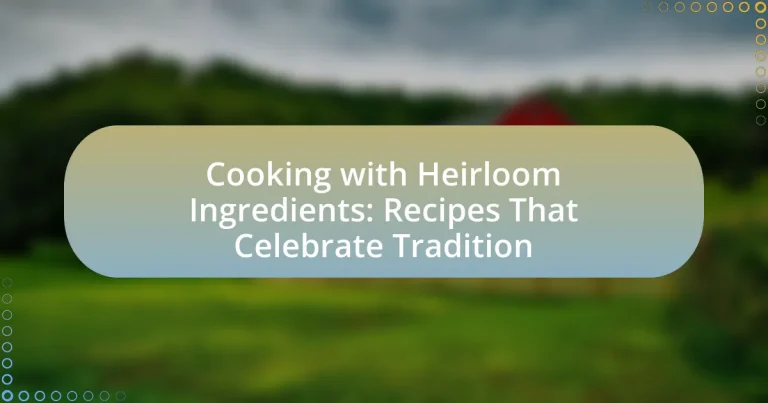Heirloom ingredients are traditional varieties of fruits, vegetables, and grains that have been preserved for their unique flavors, nutritional benefits, and cultural significance. This article explores the importance of heirloom ingredients in promoting biodiversity, supporting sustainable farming practices, and preserving culinary heritage. It highlights the differences between heirloom and conventional varieties, their defining characteristics, and their cultural significance. Additionally, the article provides insights on how to incorporate heirloom ingredients into cooking, including popular varieties, cooking methods, and simple recipes that celebrate these traditional ingredients.

What are Heirloom Ingredients and Why are They Important?
Heirloom ingredients are traditional varieties of fruits, vegetables, and grains that have been passed down through generations, often valued for their unique flavors, nutritional benefits, and cultural significance. These ingredients are important because they contribute to biodiversity, preserve agricultural heritage, and support sustainable farming practices. For example, heirloom tomatoes are known for their rich taste and are often grown using organic methods, which can enhance soil health and reduce reliance on chemical fertilizers. The preservation of heirloom varieties helps maintain genetic diversity in crops, which is crucial for food security and resilience against pests and diseases.
How do heirloom ingredients differ from conventional ones?
Heirloom ingredients differ from conventional ones primarily in their genetic diversity and cultivation practices. Heirloom varieties are open-pollinated, meaning they are bred for specific traits over generations, resulting in unique flavors, colors, and textures that are often lost in conventional farming, which typically focuses on high yield and uniformity. For example, heirloom tomatoes can have a rich, complex taste compared to the blandness often found in mass-produced varieties. Additionally, heirloom ingredients are often grown using organic or sustainable methods, which can enhance their nutritional value and environmental impact. Studies have shown that heirloom crops can contain higher levels of antioxidants and vitamins, further distinguishing them from their conventional counterparts.
What characteristics define heirloom ingredients?
Heirloom ingredients are defined by their historical significance, genetic diversity, and traditional cultivation methods. These ingredients often have been passed down through generations, showcasing unique flavors and characteristics that are not typically found in commercially produced varieties. For example, heirloom tomatoes, such as the Brandywine variety, are known for their rich taste and varied colors, which result from their open-pollinated nature, allowing them to adapt to local growing conditions. Additionally, heirloom ingredients are often grown using organic or sustainable practices, further preserving their unique qualities and contributing to biodiversity in agriculture.
Why is biodiversity significant in heirloom ingredients?
Biodiversity is significant in heirloom ingredients because it enhances genetic variety, which contributes to resilience against pests, diseases, and climate change. Heirloom varieties, often passed down through generations, represent a wide range of flavors, textures, and nutritional profiles, making them essential for sustainable agriculture. For instance, a study by the University of California found that diverse crop varieties can improve yield stability by up to 20% in varying environmental conditions. This genetic diversity not only preserves cultural heritage but also supports ecosystem health, ensuring that heirloom ingredients remain viable for future generations.
What cultural significance do heirloom ingredients hold?
Heirloom ingredients hold significant cultural value as they represent traditional agricultural practices and regional biodiversity. These ingredients often carry historical narratives, connecting communities to their heritage and ancestral farming methods. For example, heirloom tomatoes, which have been cultivated for generations, embody the unique flavors and characteristics of specific locales, reflecting the agricultural history and cultural identity of those regions. This connection to the past fosters a sense of community and continuity, as families and cultures pass down recipes and cooking techniques that utilize these ingredients, thereby preserving culinary traditions.
How do heirloom ingredients reflect regional traditions?
Heirloom ingredients reflect regional traditions by embodying the unique agricultural practices, climate conditions, and cultural histories of specific areas. These ingredients, often passed down through generations, showcase local biodiversity and traditional farming methods that have been adapted to the environment. For example, heirloom tomatoes in the American Southwest are cultivated for their ability to thrive in arid conditions, while heirloom grains in the Midwest reflect the region’s rich agricultural heritage. This connection to place not only preserves the flavors and characteristics of the ingredients but also reinforces community identity and culinary heritage, as seen in local festivals celebrating these traditional crops.
What stories do heirloom ingredients tell about our culinary history?
Heirloom ingredients tell stories of regional biodiversity, cultural heritage, and agricultural practices throughout culinary history. These ingredients, often passed down through generations, reflect the unique growing conditions and traditional farming methods of specific locales, such as the Cherokee Purple tomato, which originated from Native American cultivation. They also embody the culinary traditions and preferences of various communities, showcasing how food practices have evolved over time. For instance, heirloom varieties of grains like Red Fife wheat highlight the historical significance of grain cultivation in North America, influencing bread-making techniques and regional cuisines. By preserving these ingredients, we maintain a connection to our past, illustrating the interplay between culture, environment, and food.

How Can Heirloom Ingredients Enhance Your Cooking?
Heirloom ingredients can enhance your cooking by providing unique flavors, superior quality, and a connection to culinary traditions. These ingredients, often cultivated from seeds passed down through generations, possess distinct taste profiles that can elevate dishes beyond standard varieties. For example, heirloom tomatoes are known for their rich, complex flavors compared to commercial hybrids, which can be bland. Additionally, heirloom ingredients often have higher nutritional value and are grown using sustainable practices, contributing to both health and environmental benefits. Their historical significance also allows cooks to explore and celebrate cultural heritage through traditional recipes, making meals more meaningful and enjoyable.
What flavors and textures do heirloom ingredients bring to dishes?
Heirloom ingredients bring diverse flavors and unique textures to dishes, enhancing culinary experiences. These ingredients, often cultivated for generations, possess rich, complex flavors that differ significantly from their commercial counterparts. For example, heirloom tomatoes are known for their sweet, tangy profiles and juicy textures, which can elevate salads and sauces. Similarly, heirloom grains like spelt and farro offer nutty flavors and chewy textures, adding depth to grain bowls and side dishes. The distinctiveness of heirloom ingredients is supported by studies showing that they often contain higher levels of nutrients and antioxidants compared to standard varieties, contributing not only to flavor but also to health benefits.
How do heirloom vegetables compare in taste to modern varieties?
Heirloom vegetables generally offer a richer and more complex flavor compared to modern varieties. This difference in taste arises from heirloom varieties being bred for flavor and culinary qualities over generations, while modern varieties are often selected for traits like uniformity, shelf life, and disease resistance. Research indicates that heirloom tomatoes, for example, can have significantly higher levels of sugars and acids, contributing to their distinctive taste, as noted in studies by the University of California, Davis, which found that heirloom tomatoes often outperform hybrids in flavor assessments.
What unique textures can be achieved with heirloom grains?
Heirloom grains can achieve unique textures such as a chewy, nutty consistency, a coarse and hearty feel, and a delicate, fluffy lightness. For instance, grains like spelt and farro provide a chewy texture due to their high protein and fiber content, which enhances the mouthfeel in dishes. Additionally, heirloom varieties of corn, such as blue corn, can create a gritty texture when ground into flour, adding depth to baked goods. The diversity in heirloom grains, including varieties like einkorn and emmer, contributes to a range of textures that can elevate traditional recipes, making them more complex and satisfying.
How can you incorporate heirloom ingredients into your meals?
Incorporating heirloom ingredients into your meals can be achieved by sourcing and utilizing traditional varieties of fruits, vegetables, grains, and legumes in your cooking. For example, you can use heirloom tomatoes in salads or sauces, heirloom beans in soups or stews, and heirloom grains like farro or spelt in side dishes or salads. These ingredients not only enhance the flavor and nutritional value of your meals but also support biodiversity and local farming practices. Research indicates that heirloom varieties often have higher nutrient content and unique flavors compared to their commercial counterparts, making them a valuable addition to any culinary repertoire.
What are some simple recipes that highlight heirloom ingredients?
Simple recipes that highlight heirloom ingredients include heirloom tomato salad, roasted heirloom carrots, and heirloom bean soup. Heirloom tomato salad combines sliced heirloom tomatoes with fresh basil, olive oil, and balsamic vinegar, showcasing the unique flavors and colors of the tomatoes. Roasted heirloom carrots are prepared by tossing them with olive oil, salt, and herbs before roasting, which enhances their natural sweetness. Heirloom bean soup utilizes a variety of heirloom beans, simmered with vegetables and herbs, providing a hearty and nutritious dish. These recipes celebrate the diversity and rich flavors of heirloom ingredients, which are often more flavorful and nutrient-dense than their conventional counterparts.
How can heirloom ingredients be used in traditional dishes?
Heirloom ingredients can be used in traditional dishes by incorporating them as key components that enhance flavor, texture, and nutritional value. For example, heirloom tomatoes can replace standard varieties in classic recipes like caprese salad or marinara sauce, providing a richer taste and vibrant color. Additionally, heirloom grains such as spelt or einkorn can be utilized in traditional bread recipes, offering unique flavors and improved health benefits due to their higher nutrient content compared to modern wheat. Historical records indicate that these ingredients were commonly used in regional cuisines, thus preserving culinary heritage while promoting biodiversity in agriculture.

What are Some Popular Heirloom Ingredients and Their Uses?
Some popular heirloom ingredients include heirloom tomatoes, which are prized for their rich flavor and variety of colors, and are commonly used in salads, sauces, and salsas. Another example is heirloom beans, known for their unique textures and flavors, often utilized in soups, stews, and side dishes. Heirloom corn varieties, such as blue corn, are used in tortillas and cornbread, providing distinct taste and nutritional benefits. Additionally, heirloom squash, like the delicata, is favored for roasting and stuffing due to its sweet flavor and tender skin. These ingredients are celebrated for their historical significance and biodiversity, contributing to sustainable agriculture and culinary heritage.
Which heirloom vegetables are most commonly used in recipes?
Heirloom vegetables commonly used in recipes include tomatoes, peppers, squash, and beans. These vegetables are favored for their rich flavors and diverse varieties, which enhance culinary dishes. For instance, heirloom tomatoes, such as Brandywine and Cherokee Purple, are renowned for their sweetness and are often used in salads and sauces. Heirloom peppers, like the Jimmy Nardello and Fish pepper, add unique tastes to various cuisines. Additionally, heirloom squash varieties, such as the Delicata and Acorn, are popular in soups and roasted dishes, while heirloom beans, including the Jacob’s Cattle and Borlotti, are prized for their texture and flavor in stews and salads.
What are the best cooking methods for heirloom tomatoes?
The best cooking methods for heirloom tomatoes include roasting, grilling, and sautéing. Roasting enhances their natural sweetness and intensifies flavor, while grilling adds a smoky char that complements their rich taste. Sautéing allows for quick cooking, preserving the tomatoes’ texture and juiciness. These methods are favored because they highlight the unique flavors and textures of heirloom varieties, which are often more complex than standard tomatoes.
How can heirloom beans be prepared for maximum flavor?
Heirloom beans can be prepared for maximum flavor by soaking them overnight and then cooking them slowly with aromatics such as onions, garlic, and herbs. Soaking the beans helps to soften them and reduces cooking time, while slow cooking allows the flavors to meld and develop fully. For instance, cooking heirloom beans in a pot with vegetable or chicken broth, along with spices like cumin or bay leaves, enhances their natural taste. This method is supported by culinary practices that emphasize the importance of flavor infusion through gradual cooking processes.
What heirloom grains should you consider for your pantry?
Consider adding farro, spelt, and heirloom corn to your pantry as heirloom grains. Farro, an ancient wheat variety, is known for its nutty flavor and high nutritional value, including protein and fiber. Spelt, another ancient grain, offers a rich taste and is easier to digest than modern wheat, making it a good alternative for those with sensitivities. Heirloom corn varieties, such as Blue Corn and Glass Gem, not only provide unique flavors and colors but also retain genetic diversity, which is crucial for sustainable agriculture. These grains have been cultivated for generations, ensuring their quality and nutritional benefits.
How do you cook with heirloom corn varieties?
To cook with heirloom corn varieties, start by selecting the specific type of heirloom corn, such as Blue Corn or Glass Gem Corn, which have unique flavors and textures. Prepare the corn by soaking it in water for several hours if using dried kernels, which helps to soften them before cooking. For fresh heirloom corn, simply shuck the ears and remove the silk. Cooking methods include boiling, grilling, or roasting, depending on the desired outcome. For example, boiling fresh corn on the cob for about 5-7 minutes enhances its natural sweetness, while roasting dried kernels can be used to make polenta or cornmeal, providing a rich, nutty flavor. Heirloom corn varieties are often higher in nutrients and flavor compared to commercial hybrids, making them a valuable addition to traditional recipes.
What are the nutritional benefits of heirloom grains?
Heirloom grains offer significant nutritional benefits, including higher levels of protein, fiber, vitamins, and minerals compared to modern hybrid grains. These grains, such as spelt, einkorn, and emmer, are often less processed, retaining more of their natural nutrients. For instance, heirloom varieties typically contain more antioxidants, which can help combat oxidative stress in the body. Research indicates that whole grains, including heirloom types, contribute to improved heart health, better digestion, and reduced risk of chronic diseases due to their rich nutrient profiles and higher fiber content.
What tips can help you successfully cook with heirloom ingredients?
To successfully cook with heirloom ingredients, prioritize understanding their unique flavors and characteristics. Heirloom ingredients often have distinct tastes and textures that differ from modern varieties, so researching each ingredient’s history and traditional uses can enhance your cooking. For example, heirloom tomatoes are known for their rich flavor, which can be best showcased in simple dishes like salads or sauces. Additionally, using minimal processing and cooking methods, such as roasting or grilling, can preserve their natural qualities. This approach aligns with the culinary philosophy of many chefs who emphasize the importance of ingredient integrity in traditional recipes.
How can you source quality heirloom ingredients?
To source quality heirloom ingredients, connect with local farmers, specialty markets, and seed savers who prioritize heirloom varieties. Engaging with farmers at farmers’ markets allows you to directly inquire about their growing practices and the specific heirloom varieties they cultivate. Research shows that heirloom crops often have superior flavor and nutritional value compared to commercial varieties, as evidenced by studies from the University of California, which highlight the genetic diversity and resilience of heirloom plants. Additionally, joining community-supported agriculture (CSA) programs can provide access to a variety of heirloom produce while supporting local agriculture.
What are some common mistakes to avoid when cooking with heirloom ingredients?
Common mistakes to avoid when cooking with heirloom ingredients include overcooking, which can diminish their unique flavors and textures. Heirloom varieties often have distinct characteristics that require careful cooking methods; for example, heirloom tomatoes are best enjoyed raw or lightly cooked to preserve their taste. Another mistake is using generic recipes that do not account for the specific qualities of heirloom ingredients, leading to suboptimal results. Additionally, neglecting to source fresh heirloom produce can result in a loss of flavor, as these ingredients are often best when harvested at peak ripeness. Understanding the specific needs and qualities of heirloom ingredients is essential for achieving the best culinary outcomes.





